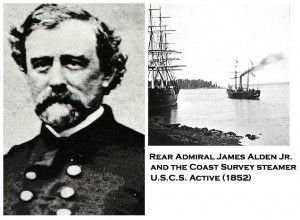By Tom Welch
The United States Exploring Expedition, commanded by Charles Wilkes, was the first government expression of interest in the San Juan Islands. Surveying the islands in 1841, Wilkes and the Expedition (also known as the U.S. Ex Ex) named many of our local features and landmarks. Shaw, Blakely, Decatur, Waldron, and other Islands were named in honor of heroes of the War of 1812 by Wilkes. He also named Mount Constitution for one of the successful U.S. Navy vessels in that war. Lieutenant James Alden was a member of the Expedition, on board the ‘Porpoise’, and was later active in our area in another capacity.
In 1855 James Alden was Captain of the U.S. Survey and Revenue Vessel ‘Active’, engaged in survey work for the Joint U.S.-British Boundary Commission. The ‘Active’ was a wooden-paddle steamer, converted from a schooner-rigged vessel purchased from a commercial west coast firm and refitted at Mare Island. (Active Pass, between Galiano and Mayne Islands in the Canadian Gulf Islands, was named for Captain Alden’s vessel.)
One day in 1857, the ‘Active’, in company with the British steamer ‘Plumper’, was surveying to fix the boundary line in Semiahmoo Bay near Bellingham when sailors from the ‘Plumper’ arrested a white man named Macauley. Wanted for selling liquor to the survey camps, Macauley was to be transported to Fort Victoria for trial. Aboard the vessel on the way to Victoria, Macauley entertained the sailors with tales of the riches in gold to be found along the Fraser River…and backed his stories up by showing a very large amount of gold dust he claimed to have gotten in trade from the Fraser River Indians. When the sailors reached San Francisco on assignment later that year, tales of the fabulous gold find sparked the Fraser River Gold Rush of 1858.
Many of the earliest pioneer settlers of the San Juan Islands claimed their first views of these islands were seen while heading for the Fraser River from Port Townsend or Victoria. Stringent measures by the local authorities prevented many from reaching the upper gold regions of the river, and disappointed goldseekers meandered back through the islands as they left the area. Some, seeing opportunity in the free land available, stayed and married local native women. Louis Cayou of Deer Harbor, William Moore of Olga, and George Miller of Crow Valley were all very early pioneers on Orcas who had been to the Fraser before settling here.
It is interesting to note the connection of Captain Alden to the Wilkes Expedition, and the linkage between the original survey work of the U.S. Ex Ex, the later fixing of the boundary line by the Boundary Commission, and the Fraser River Gold Rush, which contributed significantly to the original white settlement of these islands.
(Welch will tell more stories from Salish Sea lore as he hosts the [intlink id=”9708″ type=”post”]cruise[/intlink] tracing the path of the 1841 Wilkes expedition on September 12. To sign up for the cruise, call 376-6566)
**If you are reading theOrcasonian for free, thank your fellow islanders. If you would like to support theOrcasonian CLICK HERE to set your modestly-priced, voluntary subscription. Otherwise, no worries; we’re happy to share with you.**








